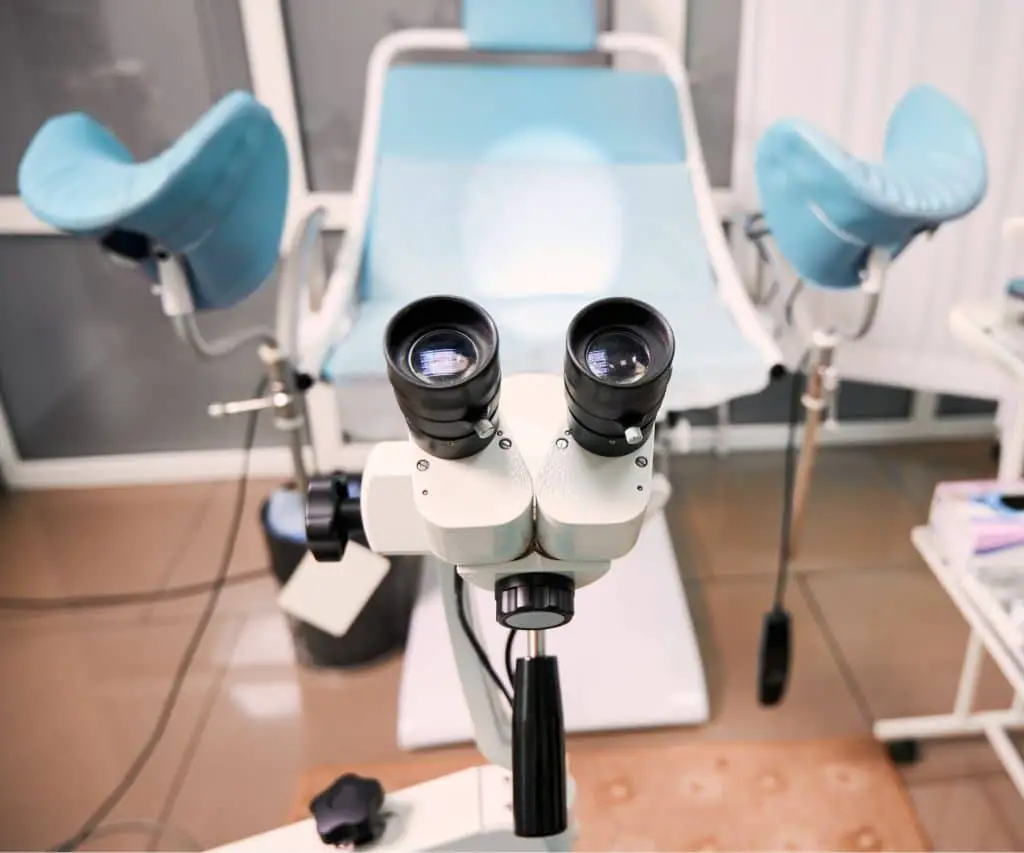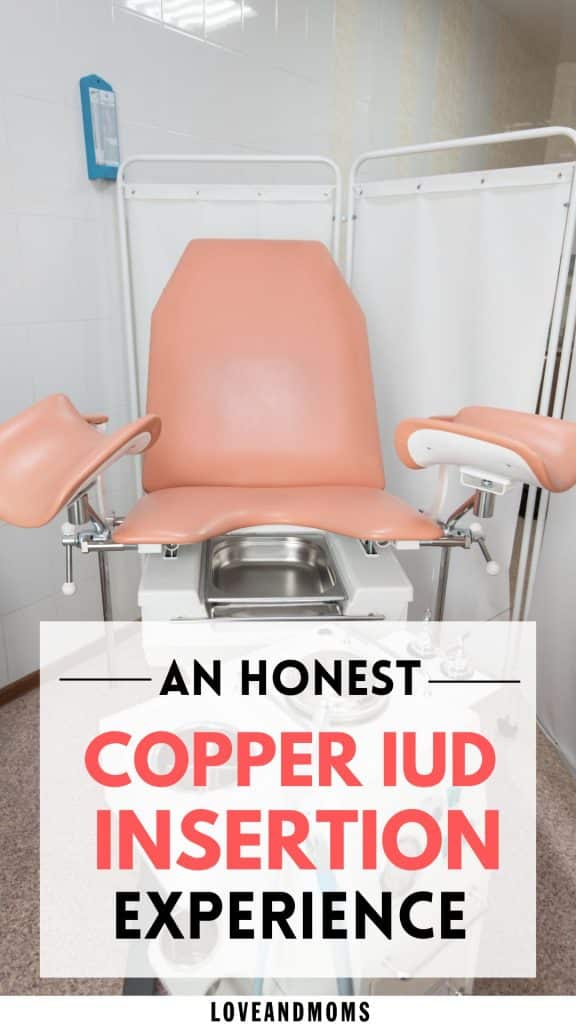This post is my honest Paragard insertion experience after six weeks postpartum.

For more helpful and fun content, follow me on Pinterest!
The Copper IUD is becoming increasingly popular as a highly effective and non-hormonal birth control option leading many of us to look up Paragard insertion experiences.
Finding the proper birth control that works for you is integrative into your reproductive health and family planning.
From hormonal to simply tracking your cycle, there are many options for you as a mother to take control of your reproductive ability.
You, of course, are welcome to leave it up to chance if that is the route you want to take and that works for you and your spouse.
However, if you aren’t keen on the magic and suspense of leaving a pregnancy up to chance, finding a birth control method that works for you is best.
I did a lot of research while pregnant to see which type of birth control would work for me after having my baby.
At the time, we knew, at the very least, we would want to wait up to 4-6 years before having another pregnancy.
We have seen the two under 2 take place with family and friends, and we knew that just was not the route we wanted to take for our family and parenting journey.
I wanted to give my body a decent break from pregnancy and childbirth.
I was nervous about birth control, copper IUD, and its insertion process, but it was necessary.
This post is my honest Paragard insertion experience.

Finding The Right Option
I wanted something practical and nonhormonal, and I didn’t breastfeed and knew I wouldn’t before I had my daughter, and I wanted my hormones to return to balance as quickly as possible.
So hormonal birth control was a big no for me.
That’s when I considered the Copper IUD!
My body had its share of hormones pumped through it endlessly by the end of my third trimester.
I was ready to get back to balance.
Pregnancy hormones and the drop that took place after I just wanted to try my best to get my body back to equilibrium while still being protected from an unplanned pregnancy.
I was also no stranger to natural family planning and had been off hormonal birth control for nearly three years when I got pregnant.
I used an app to track my cycle and avoided sex on my most fertile days.
It worked well, and I never got pregnant until I planned it, and then I got pregnant immediately.
This was an effective nonhormonal method for me before kids since I had the time and bandwidth to be proactive and intentional about it.
However, after having my daughter, I knew it probably wouldn’t be as easy, which could leave huge margins for errors.
The Copper IUD Birth Control
Non-Hormonal Option
I wasn’t willing to take any risks in getting pregnant again.
Vasectomies are the most effective methods of birth control, considering their sterilization.
Still, it isn’t entirely effective for at least six months or until your man has provided two semen samples that both turned out negative.
I knew I would need a backup birth control method before my husband’s procedure.
So, I looked into the Paragard Copper IUD.
Initially, I was a bit squeamish about having a foreign object in my body, in my uterus.
There was a massive disparity in experiences regarding insertion and living with the IUD.
The copper IUD pros and cons lists were a little over the place.
My body is generally injury prone, sensitive, and prone to freak accidents.
This concerned me, of course.
It made me worry I would be the rare case of complications.
Just Gotta Bite The Bullet
However, there are risks for everything, and the risks didn’t outweigh the peace of mind I would have known I couldn’t get pregnant again.
To be honest, a few years before I had my daughter, I had inquired about an IUD, the hormonal one.
I set up an appointment, and they prescribed me a cervix dilator to make the insertion easier for the doctor and me.
I was so nervous, though, I felt like there was already too much intervention to keep me from getting pregnant, and I was doing just fine planning naturally, so I chickened out and canceled my appointment.
This was before kids, though, and more often than not, no woman is more afraid of getting pregnant again than a mom who just had a baby.
There was no room for error now, and I needed to be a big girl and face it head-on.
Also, given that I had a baby then, I didn’t need additional medication to soften my cervix.
Getting an IUD couldn’t be more difficult or painful than pregnancy and birth.
The Paragard Insertion
Preparation
I was treated at Natural Beginnings Birth & Wellness Center in Statesville, North Carolina, during my pregnancy.
My doctor treated me the whole way, and when I went into labor, he had just returned from vacation and was at the airport.
He boogied over and was there to deliver my daughter.
I was very comfortable and talked to him about birth control options before delivery.
We discussed the copper IUD and decided it would be my best method.
The few minutes of discomfort that may ensue upon insertion is worth ten years being baby-free.
We scheduled the appointment during my next expected period.
This is general practice for IUD insertions since your cervix is more dilated.
The Appointment
Of course, I was nervous, but I couldn’t imagine it would be worse than birth and labor.
I took some ibuprofen about an hour before the implantation.
Once I got to the office, I signed all the liability paperwork, and they took me back.
They had the chair with the stirrups and a medical sheet to go over my legs.
The nurse told me to undress from the waist down and that my doctor would be in momentarily.
Honestly, I was just ready to get it going.
For me, in general, the waiting is always worse.
I saw the Copper IUD in its packaging on the cabinet counter, and I was surprised to see how small it was, maybe about ½ inch or so.
Then I put the sheet over my legs and feet in the stirrups.
My doctor came in and explained the process to me.
He also explained everything he was doing as he was doing it, which was nice, so I knew what to expect and what was happening next.
The Procedure Begins
At first, he inserted a speculum, then cranked it open, as you would expect with a routine pap smear.
This, to me, was the most uncomfortable simply because it’s so cold and heavy and in you the whole time.
He brought a light down there and cleaned the surface of my cervix with what looked like a long Q-tip.
He then took this instrument to measure the length of my cervix, which felt weird.
It felt like a mixture of bubble guts and a menstrual cramp.
It lasted about a minute, then went away.
Uncomfortable but not unmanageable.
Then once he had my measurement, he adjusted the Copper IUD to fit me.
Then it was insertion time.
I barely felt it because I can’t remember how it felt, so I know it wasn’t that bad.
Then it was done!
I was now protected for ten years with only maybe a few minutes of discomfort and was relieved I didn’t experience one of the crazy horror stories you read online.
I didn’t vomit, pass out or nearly die.
It was mild discomfort for less than 5 minutes.
A Soft Cervix
I had this done six weeks postpartum during my first cycle after giving birth.
Having a baby and then being on my period helped make the experience more manageable.
My cervix was already more dilated than before from having a baby, and with my period underway, it only made insertion easier.
*If you’ve never had a baby, request a cervix dilator for the procedure.
I’ve had friends say this makes a big difference.
The Copper IUD Aftermath
Heavy Duty Periods
My first cycle with the Copper IUD was rough.
Copper IUD bleeding is no joke.
PMS was intense, and I felt sick for about a day.
My first cycle was 17 days long.
Yes, 17 days of heavy period bleeding and cramping.
This is the most common side effect of the Copper IUD, so I knew what to expect.
I would be ill for the first couple of days of my first three cycles.
Straight up sick.
When it comes to a Copper IUD period, the first few months are brutal; I’m not going to lie.
My stomach would hurt, I would have a headache, be super sluggish, and it would be a struggle to get through the day where I couldn’t get back in bed fast enough.
It would only last a few days and leave as quickly as it came.
With this IUD, copper creates inflammation in the uterus, and the bleeding is to detox your body from excess copper.
Thus, you’re left feeling poopy while your body gets the hang of it.
After My Body Adjusted
Being nearly a year in, I haven’t had this happen with my cycles in at least eight months, so my body eventually got over it and adjusted.
Since that first cycle, every cycle has gotten better and less long and intense.
I have experienced twelve complete cycles with the Copper IUD; my periods are now how they were before I got pregnant.
Roughly 7 days long, very mild to minor cramping, and no crazy amounts of bleeding.
My periods are manageable now and not nearly as laborious or debilitating as initially.
My husband has had his vasectomy since, and we are advised to keep the Copper IUD in for at least six more months before his procedure takes full effect.
I will then remove my Copper IUD and be birth control free for the first time in over 11 years!
And now, for the rest of my life!
Overall, The Paragard IUD Insertion Was Benign
All in all, my Copper IUD experience was a good one.
My doctor and nurses were great.
The insertion was swift and benign.
My cycle returned to normal with time, and I have experienced few side effects.
If you are looking for a relatively permanent non-hormonal birth control option that works, the copper IUD is viable.
Remember, insertion can be a little more uncomfortable if you’ve never had a baby.
However, when I inquired about the copper IUD before I was pregnant, they would have offered me a cervix dilator.
It would help to help soften and open up my cervix.
This aids in a more quick and smooth insertion.
All in all, I am happy with my Paragard IUD.
If I did want more kids, I would keep it until we were ready for more.
Once the copper IUD is out, you can get pregnant immediately, which is lovely.
I understand that the insertion portion is what makes most women squeamish.
It is scary, and you’re highly vulnerable.
If that isn’t for you, that is fine.
Finding the proper birth control can be difficult.
Find the best option that works for you and your body.
If you decide to give the copper IUD a go, awesome!
After the initial adjustment period, you will forget it’s even there and will be protected against pregnancy for 10 years!
Woop Woop!

